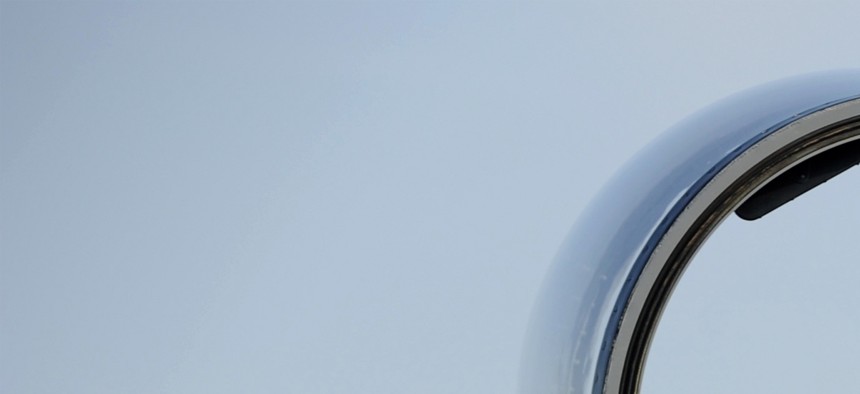
A T-38 pilot prepares to take off. Airman 1st Class Melissa Siegmund/U.S. Air Force
Northrop Secretly Building Jet for Air Force Trainer Competition
Northrop Grumman has abandoned plans to jointly pitch the BAE Systems Hawk jet training plane for the U.S. Air Force, instead opting to build a new aircraft.
Many in the defense community were scratching their heads when Northrop Grumman announced in late 2011 that it would partner with BAE Systems to pitch the single-engine Hawk jet to train the U.S. Air Force’s future pilots.
After all, the Hawk was first made in the 1970s, even though the team was pitching a newer model, with more modern electronics. The jet it would replace, the Northrop T-38 Talon, entered the Air Force fleet in 1961.
More than three years later, the companies have abandoned that plan and Northrop revealed it has been secretly building a new jet in a Mojave Desert aircraft hangar.
Northrop executives believe the new clean sheet design, or purpose-built aircraft, will better suit the Air Force’s parameters for the new jet trainer, called T-X. The letter T in an aircraft designation stands for trainer. The X simply means the number of the plane has not been determined yet.
“Our goal is not to win with a certain solution, our goal is to win with what the Air Force wants,” said Marc Lindsley, Northrop Grumman T-X director of programs.
Two years ago, Northrop tasked subsidiary Scaled Composites to come up with plans for a new plane. Scaled, as it’s often called, is the aerospace development company behind SpaceShipOne, the aircraft that flew the first manned private space flight in 2004.
“Scaled’s ability to do things quickly, understand customer requirements and design the airplane, is complementary to Northrop as a designer and developer,” Lindsley said.
The Air Force has not yet set all the parameters for the new trainer, but has been slowly trickling wants for the jet. The Pentagon’s 2016 budget proposal, released on Monday, revealed the Air Force wants to use the new jet for simulating enemy aircraft in addition to pilot training.
The Air Force plans to spend more than $600 million on the trainer project over the next five years, according to budget documents.
In recent years, as the Air Force announced more requirements, Northrop officials began to question whether the Hawk was the best option and instead opted to design and build a new aircraft.
The company has partnered with L-3 Link Simulation and Training for ground-based training equipment as well as engine maker General Electric and is in negotiations with BAE to provide other training equipment.
“We’re actually proposing not just the aircraft, we’re proposing ground systems as well,” Lindsley said.
But beyond that, Northrop’s not saying much about the plane because it doesn’t want competitors to steal its ideas. Lindsley said the jet is expected to fly for the first time later this year and the Air Force is aware of the company project.
(Related: Here’s What You’ll Find on the Fighter Jet of 2030)
“[Northrop is] trying to send message that they’re a high-tech design company and if you’re pitching a very [19]70s trainer, that just sends the wrong message,” said Richard Aboulafia, vice president for analysis at the Teal Group consulting firm.
Aboulafia likened the Hawk to “your uncle’s Oldsmobile with wings,” which was surprising when compared to the revolutionary aircraft the company has built more recently, including the B-2 stealth bomber, the Navy’s X-47 drone and Global Hawk drone. Northrop also builds the center fuselage for the Lockheed Martin F-35 Joint Strike Fighter in Palmdale, Calif.
By announcing the new training, Northrop is “sending a message that the they’re a high-tech, airframe integrator and aircraft prime,” Aboulafia said.
The project also shows the Pentagon that the company is willing to spend its own money on research and development, something Defense Department officials have pushed in recent years.
Even though the trainer program is still in its infancy, companies have been eagerly preparing for looming competition for several years. That’s because T-X and a new stealth bomber program are the only two major new Air Force projects on the horizon.
The Air Force is expected to buy at least 350 new trainer aircraft, which will replace the T-38 Talon. The Air Force uses the supersonic jet to train pilots before they fly fighter and bomber aircraft.
In addition to the new Northrop plane, there are a number of other aircraft in the mix for the T-X competition, including the Italian-made Alenia Aermacchi T-100, a twin-engine jet already purchased by Israel, Singapore and Italy. For the T-X competition, Alenia has teamed with General Dynamics C4 Systems.
KAI and Lockheed Martin have teamed to pitch the T-50, a Korean-made twin engine jet, that has been purchased by South Korea, Iraq, Indonesia and the Philippines. Boeing has teamed with Sweden’s Saab to pitch a new aircraft.
Finally, there is the Textron AirLand Scorpion, a new twin-engine, composite aircraft that is in development.




